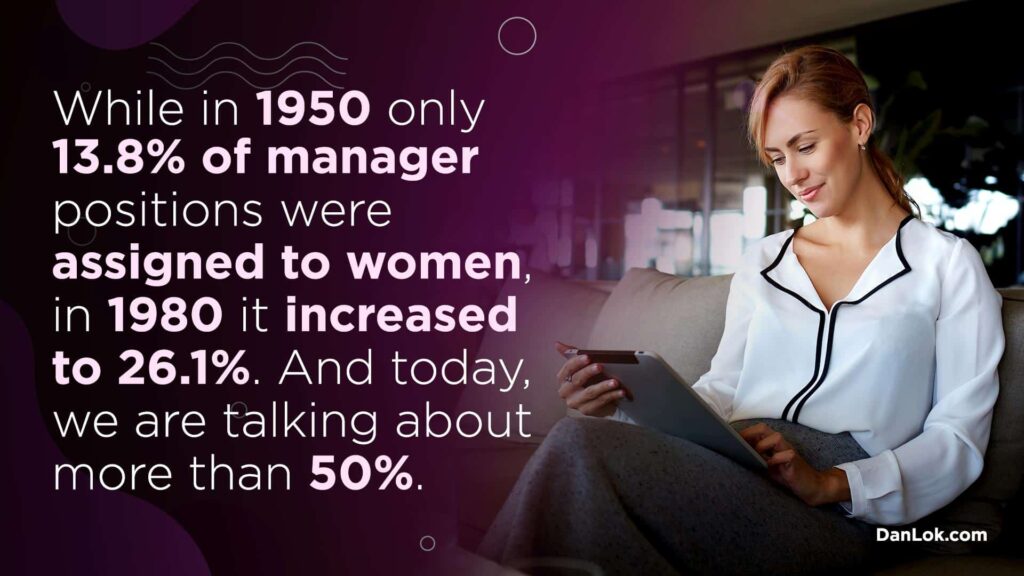How are the differences between men and women in leadership evolving today? Are there any significant differences between men and women when it comes to business and leadership?
I believe that a true leader possesses certain skills and certain personality traits. It doesn’t matter if you are a man or a woman. Leadership is more connected to your personality and skills. Therefore, I like to take a more individualistic approach. Some people are suited to be good leaders and some aren’t. It’s not so much about gender, and more about if your skill level and personality type suits leadership.
On my team, there are plenty of skilled men and women in very senior positions. I think that the marketplace is hungry for more female leaders. So while men might have been favored by society as leaders before, the era of female leaders is fast approaching.
Still, it can’t be completely dismissed that there are some general differences between men and women. This is often because of the different ways men and women are treated by society, and how they’re treated as children. Keep in mind, these are very general differences. At the end of the day, we are all different and only some of those differences can be explained by gender.
You also shouldn’t view these differences as set in stone. Think about the general direction that society is viewing gender differences right now. It might change or it might stay like this for a while. All I know is, some of the best leaders in our world today, are female.
Let’s discuss how the leadership differences between men and women are evolving today.
What Are Some Common Leadership Differences Between Men and Women?
Let’s have a look at some general trends in regards to men and women in leadership.
In recent years, women have expressed a higher level of interest in skyrocketing their careers. Thanks to a higher awareness in society, more and more women are now more readily taking on leadership positions. The men no longer need to be the breadwinner of the family. Some women are even choosing a high-paying career over spending more time with their family. Families and household dynamics are definitely changing.

When it comes to women in leadership, society is slowly but steadily becoming less discriminatory and more accepting. Many companies have certain policies and measures to promote more female leaders. Such measures don’t come from looking down on women. Instead, companies nowadays know that women in leadership positions can create phenomenal results.
The percentage of women in leadership positions has constantly increased. While in 1950 only 13.8% of manager positions were assigned to women, in 1980 it increased to 26.1%. And today, we are talking about more than 50%. Share on XOne problem, however, is that women don’t yet find themselves in the top positions very often. They are more likely to find themselves in middle-management positions. So when it comes to differences between men and women, men are still more present in top leadership roles than women are. But we can see that this is changing, and we can at least see the number of women entering into top leadership positions rising.
Let’s look at management boards, for example. In the US, approximately 19.2% of the board seats of the largest companies are held by women. In Canada, approximately 20.8% of board seats are held by women.
There are also fewer women in top positions when it comes to the government, law or medicine.
So, there is definitely still a lot of room for women who want to strive higher.
Now, let’s have a look at leadership styles. Are there any differences between men and women when it comes to leadership style?
Are Men and Women Leading in Different Ways?
When it comes to differences between men and women, there is always an important question asked. Do they have different leadership styles? And, if the answer is ‘yes’, which style is more effective?
Again, I would argue that individual people have very individual leadership styles, regardless of gender. It’s not so much connected to their gender as it is connected to their personality. However, some might argue that women are more likely to have certain personality traits that men are less likely to have. So, let’s explore this.
First, I want to clarify that I still believe that regardless of gender, different people will naturally have different leadership styles. When we look at two men, for example, one of them might have a certain leadership style, and the other would lead a completely different way. And the same goes for women. So, differentiating leadership by men or women might be too one-dimensional of a viewpoint.
However, we can’t ignore some of the general trends that do relate to gender. There are trends we can observe in the leadership styles of men and women. In many case studies, women proved to be as effective leaders as men – sometimes even more effective. But there are still some stereotypes that only die down slowly.
Many people still possess a bit of a bias in terms of favoring male leaders. However, many people who worked under female leaders would often say they want a female boss again, because they liked having a female boss.
Often, one of the big differences between men and women is their self-perception and self-confidence. Women are more likely to be harder on themselves and women tend to experience imposter syndrome, where they experience low self-esteem and feel undeserving of their leadership position. So, while many women might think to themselves, I’m not good enough to do this, men are more likely to exaggerate their self-confidence. Men are more likely to think to themselves, I can do this. That’s why men might be more proactive when it comes to applying for a leadership job. They’re confident they can do the job, and can easily learn what they do not yet know.
So, let’s assume there is an opportunity to apply for a leadership position. The woman might think she has to wait and learn more, before applying. The man, on the other hand, might be more likely to believe he is good enough and can learn the rest along the way.
Women tend to undervalue their skills. If you are a female leader and want to be more effective, I would suggest working on your self-perception and self-confidence. You don’t want to miss out on great opportunities because of self-limiting beliefs.

Differences in Men and Women’s Leadership Approaches
Both men and women have the ability to be very competent leaders. When an opportunity presents itself, either gender can succeed.
Some people would argue that the differences between men and women lay in their way of working or their approach to leadership. Men in leadership positions often focus on the following: Accomplishing tasks, implementing structure, and establishing power.
Women, on the other hand, often focus on caring for the team on a personal level, motivating the team and subordinates, listening to the team member’s ideas, and problem-solving.
In other words, men tend to have a more authoritarian leadership style. They derive their power from their status. Men tend to take less advice from the team when it comes to leadership decisions. They might be more strict, they might come across as less caring, and give more direct commands.
Women generally have a more collaborative management style, encouraging participation and listening to ideas. They derive their power from effectively managing and cooperating with their team. So, when a female leader makes a decision, she would probably listen to the team’s suggestions first. After the decision is made, she would also communicate why and what that will mean for the team. Female leaders often provide more details and explanation regarding their decisions, than male leaders do.
In other words, women often lead with a transformational approach, while men take a transactional approach. Women spend more time with subordinates and focus on inspiring them. Men are less involved and often just give orders with no further communication. This also means men tend to provide very clear instructions. They are good at communicating who on the team is or is not meeting their expectations.
However, there are also men who take the collaborative or transformational approach. And there are also women who are very authoritarian or transactional. You see, I’m not talking in absolutes, I’m just talking about general tendencies here. Both of these leadership styles have great advantages but also have their limitations. Effective leaders can’t be too rigid about their approach.

Differences Between Men and Women – Who is More Likely to be a Better Leader?
Some people would argue that women are, in fact, better leaders than men. They exhibit a lot of leadership traits that men tend to lack.
A US consulting firm called Zenger & Folkman, conducted a study on leadership. They ranked men and women on 16 different leadership characteristics. The conclusion? Women ranked better than men in 12 of the 16 characteristics.
For example, the women exhibited better communication skills than the men. They were more respectful of the culture and ethics of a business, and exhibited more patience. If women are this great in terms of leadership skills, we definitely want to see more of them in top leadership positions.
The thing is, men and women, go through different life experiences as they are growing up. They get different advice from their parents and teachers. Women, for example, are often encouraged to be more nurturing, caring or emotional than men. They might have different role models, too. That could be another reason for their different leadership approaches.
Again, this is very generally speaking. People are already different as individuals, regardless of gender, even if gender plays a factor. Individual personality differences, however, might be bigger factors than the differences between men and women.
So, even if women ranked higher in leadership characteristics in Zenger & Folkman’s study – and we definitely want more female leaders – no two people really have the same leadership style.
Every company is different, so one approach might be perfect for one business, and not work at all for the next. There are many variables. That’s why comparing women’s and men’s leadership skills is so hard to do.
I would argue no gender is better than the other. One person might simply possess a specific leadership style that suits a certain company perfectly. It’s all very situational.
What are Some General Effective Leadership Traits?
Now there might be some differences between men and women as leaders. Yet, I want to suggest to look at something else. At the actual person. To determine if a person is a good leader, let’s look at their actual traits. What are they good at and what do they lack? Are they willing to learn?
What should a good leader act like?
I noticed that the best leaders have something in common. They have a clear vision and follow their mission no matter what. They have this clear idea of where they want the team or company to go, and guide others. So great leaders, they… Share on XEffective leaders don’t necessarily lead by authority. Instead, they lead by persuasion. What does that mean? They inspire others to work harder. That’s what a great leader does. They find ways to motivate their team to work harder and work smarter.
Great leaders communicate their “why”. Leaders should always make their team understand the goals and objectives. They make sure others understand what they are doing, and why they are doing it. Such a leader would want to find out what motivates their team members. They make sure everybody is working hard because they want to, not because they have to.
So, rather than forcing others to work hard, effective leaders lead by example and figure out their team’s primary motivators.
Their team then naturally wants to follow their lead. Great leaders, no matter if they are male or female, inspire hope and hard work in others. They give them something to believe in and specific goals to work towards. And they remind others of the common goal often. Important leadership skills and traits include clarity, vision, and charisma.

What Are Women Better At?
When we discuss the differences between men and women, I’m convinced we can learn a lot from each other. This is, again, more generally speaking. But there are some things male leaders can learn from female leaders, and vice versa.
When it comes to leadership, what do women tend to be better at?
Women tend to be better communicators. They usually excel in verbal communication. And that kind of communication is important when you are in a leadership position. Think about it: How could a leader communicate their vision and mission without verbal skills or listening skills? That’s why women are great leaders. They are also great at problem-solving and at nurturing the skills of their teammates.
Women often take more initiative than men do, which is another great characteristic to have as a leader. Most people would think that men take more action, but actually, the opposite is often true. Women often have to fight harder to actually get leadership positions. That’s why they are used to taking initiative. They have great work ethic and think ahead.
Another difference between men and women is this: Women very often work twice as hard. Here’s why: Very, very often, when a man and a woman share a household, both work full time. However, the woman is the one who often also takes care of the household and possibly also organizes the care of the children. So, they actually get two or three jobs done at the same time. The willingness to work harder often makes women less lazy and more excellent leaders.
What Men Are Better At?
What do men excel at and what can we learn from them?
Most men don’t face the same obstacles a woman would face – especially if they want to become a leader in a top position. But that doesn’t necessarily mean leadership comes to them easy. Becoming a leader is competitive for both men and women. That’s why at the end of the day, it’s about the value they can bring to the table.
Most successful men have great self-confidence. While women tend to doubt their skills, men are more likely to rise to the challenge without self-doubt. That allows them to take action faster and get promoted – before their female colleagues even feel ready to try. Effective leaders can’t be indecisive, and men tend to be less indecisive and less hesitant than women.
Men are also great when it comes to focusing on short-term outcomes. Women tend to look at the long-term results and want to know that everything goes well along the way, even if it takes longer. Men, on the other hand, want to see results faster. So they would measure their success by creating results consistently.
And as I mentioned before, men often think in a bit more of a strategic manner. When it comes to leading a company, a strategy is important. If there is no system or strategy behind a business, it won’t last long.

Why We Need More Female Leaders
I personally think that the differences between men and women aren’t that major. Both men and women can make very good leaders. When you look at the information that is out there, many people argue women are better leaders than men. Now, I believe, this shows us how hungry the market is for female leaders and female CEOs.
In the average household, women make most of the purchasing decisions. That’s why females are needed in the marketing world, too. Women have great social and financial capital.
In the global market, companies can’t ignore 50% of the population – which is also half of the workforce. If a business would do that, they wouldn’t stand a chance against their competition. A company where all of the senior-level staff are men, would probably not do as well as a company that also had females in senior-level positions.
What does this mean for the differences between men and women in leadership? And how are the differences evolving? The market is slowly becoming more inclusive. So I’m confident we will see even more of an increase in female leaders in the next years.
The differences between men and women are definitely not easily explained. No longer is the old cliche, “men are rational and women are emotional” assumed. If anything, both men and women want to be both emotional and rational to be effective as leaders. For example, if a leader is able to connect with their subordinates on an emotional level, and evoke positive emotions, that team member might perform better. And, being rational and logical are of course important traits as well.
Hungry For More Business-Related Advice?
As you read this article, perhaps you started to wonder if you would be an effective leader. On my YouTube channel, I regularly provide advice about leadership and other business-related topics.
I run several high-level businesses and in my YouTube videos, I provide insights on how I reached my current level of success – after immigrating to Vancouver from China and being 150k in debt. Now I’m a multi-millionaire, and my followers come to me for advice. What would it mean to you to learn from a millionaire, and get tips on how to avoid common pitfalls, and learn how to be an effective leader?
If that is something you want or need, then subscribe to my free YouTube channel. See you there. Click here to subscribe.




